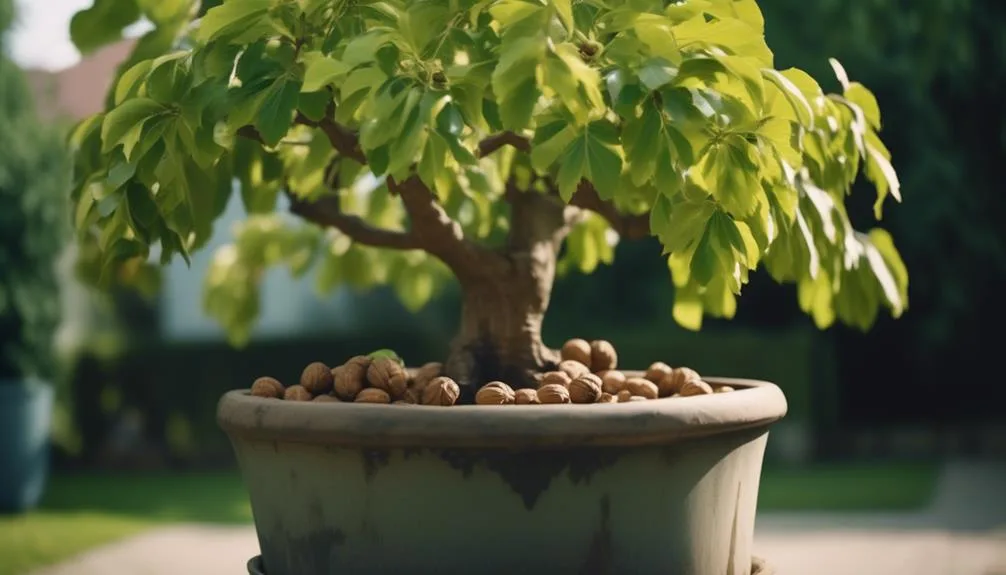Thinking about growing a walnut tree in a pot on your patio or balcony? It may sound challenging, but with the right knowledge and care, it's possible.
There are factors to consider, from pot size to growing conditions. Whether you're an experienced gardener or just starting out, the idea of growing walnut trees in pots is intriguing.
Let's explore the possibilities.
Key Takeaways
- Choosing a suitable pot size and ensuring proper drainage is crucial for growing walnut trees in pots.
- Providing ideal growing conditions, such as well-draining potting mix and sufficient sunlight, is important for the tree's health.
- Nutrient requirements should be met by using well-draining soil with the right pH level and applying balanced fertilizer formulas.
- Pruning and training the tree regularly will help maintain its shape, promote growth, and improve fruit production.
Suitable Pot Sizes for Walnut Trees
When choosing a pot size for your walnut tree, it's crucial to provide ample space for the roots to grow and thrive. The root space is essential for the tree's overall health and productivity. Select a container with proper drainage to prevent waterlogging, which can lead to root rot.
A good rule of thumb is to choose a pot that's at least 24 inches deep and wide to accommodate the walnut tree's extensive root system. Ensure that the selected container is made of durable material to support the tree's weight and withstand outdoor conditions.
Regular maintenance, such as checking the pot for adequate drainage and repotting as the tree grows, is necessary to promote healthy root development. By providing the right container with sufficient root space and proper maintenance, you can successfully grow a walnut tree in a pot.
Ideal Growing Conditions for Potted Walnut Trees
To ensure the optimal growth of your potted walnut tree, it's essential to create ideal growing conditions that complement the suitable pot size you've chosen to accommodate its extensive root system.
- Container Gardening
- Select a well-draining potting mix to prevent waterlogging, which can lead to root rot and other issues.
- Consider using a large, sturdy container to provide ample space for the walnut tree's roots to spread and access necessary nutrients.
- Indoor Gardening
- Place the potted walnut tree in a location that receives at least 6-8 hours of sunlight daily, as walnut trees thrive in full sun conditions.
- If natural light is limited, consider supplementing with grow lights to meet the sunlight requirements of the walnut tree.
Creating the ideal growing conditions for your potted walnut tree is crucial, especially in the context of container gardening limitations and indoor gardening sunlight requirements.
Nutrient Requirements for Potted Walnut Trees
Nutrient requirements for potted walnut trees can significantly impact their growth and overall health. To ensure optimal development, it's crucial to pay attention to soil composition and fertilizer application. For potted walnut trees, the soil should be well-draining, with a pH level between 6 and 7. A mix of loam, sand, and organic matter such as compost is ideal. When it comes to fertilizer, a balanced formula such as 10-10-10 or 8-8-8 should be applied in early spring and late summer. Additionally, using a slow-release fertilizer can provide a steady nutrient supply over an extended period. Properly meeting the nutrient requirements will promote healthy foliage, vigorous growth, and a bountiful harvest.
| Nutrient | Function | Application |
|---|---|---|
| Nitrogen | Promotes leafy growth | Apply in early spring |
| Phosphorus | Stimulates root development | Apply in early spring |
| Potassium | Aids overall health and disease resistance | Apply in late summer |
Pruning and Training Potted Walnut Trees
First, it's essential to understand the basic principles of pruning and training for potted walnut trees.
- Pruning Techniques:
Regular pruning of potted walnut trees is vital to maintain their shape and encourage healthy growth. Use sharp, clean pruning shears to remove dead or diseased branches and any crossing or rubbing branches. This helps improve air circulation and sunlight penetration, leading to better fruit production.
- Root Development:
Training the roots of potted walnut trees is crucial for their overall health and development. Regularly check the root system and consider root pruning if the pot becomes crowded. This encourages the growth of new feeder roots and prevents the tree from becoming root-bound, ultimately promoting better nutrient uptake and overall vitality.
Challenges of Growing Walnut Trees in Pots
When growing walnut trees in pots, you may encounter various challenges that require careful attention and proactive management for the trees to thrive. Two significant challenges are the root system and water retention. Walnut trees have an extensive root system, and when confined to a pot, they can become root-bound, inhibiting their growth. Additionally, proper water retention is crucial for the health of walnut trees. Insufficient water can lead to stress, while excessive water can cause root rot. To help you understand these challenges better, here's a table outlining the key challenges and their management:
| Challenges | Effects | Management |
|---|---|---|
| Root System | Root-bound | Regular repotting to provide space for root growth |
| Water Retention | Stress, root rot | Use well-draining soil, monitor soil moisture regularly |
Understanding and addressing these challenges will be essential for successfully growing walnut trees in pots.
Conclusion
In conclusion, while growing walnut trees in pots presents challenges, it's possible with the right care.
By choosing a large pot, providing ideal growing conditions, and ensuring proper care, you can enjoy the rewarding experience of growing walnut trees in pots.
Consider the potential for smaller yields and the need for dedicated attention, but with patience and effort, it can be a fulfilling endeavor.
Happy gardening!

